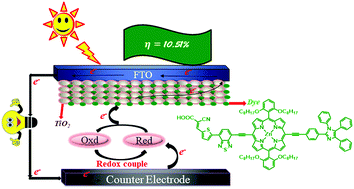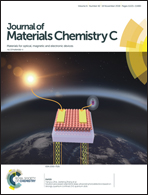Kinetics of dye regeneration in liquid electrolyte unveils efficiency of 10.5% in dye-sensitized solar cells†
Abstract
Due to their fabulous performance, porphyrins are considered to be emerging materials for dye-sensitized solar cell applications (DSSCs). Herein, we have designed and synthesised four novel porphyrin sensitizers tethered with a triphenylimidazole group as the donor, a porphyrin macrocycle as the π-spacer and 4-ethynyl phenyl (LG15), 5-ethynylthiophene (LG16), 2,1,3-benzothiadiazole (BTD)-phenyl (LG17), and BTD-thiophene (LG18) as auxiliary acceptors and either a carboxylic acid or cyanoacrylic acid anchoring group, which resembles the structure of a donor–π-bridge–acceptor (D–π–A). The absorption spectra of LG17 and LG18 are red-shifted, when compared to LG15 and LG16, due to the presence of extended π-conjugation of the BDT group in its molecular structure. The red-shifted absorption spectra of LG17 and LG18 result in highest efficiency of 10.11% and 10.51%, respectively. Optical and electrochemical properties, and Density Functional Theory calculations of LG15–LG18, suggested that LG18 exhibits strong absorption and optimized lowest unoccupied molecular orbital (LUMO) aids the injection of electrons very effectively from the excited state of the dye into the TiO2 conduction band. Both LG17 and LG18 exhibit broad incident to photon conversion efficiency (IPCE) and the onset extends up to 950 nm, with >80% at 700 nm. Current density–voltage (J–V) curves of LG15–LG18 revealed that LG17 and LG18 exhibit highest short-circuit current density of 20.64 and 21.43 mA cm−2 resulting in power conversion efficiency (PCE) of 10.11% and 10.51%, respectively, in a liquid I−/I3− redox couple electrolyte. Bulky donor groups, π-spacer length and anchoring groups have significantly contributed to achieving high efficiency in a liquid redox shuttle that can be helpful to make efficient DSSCs for future generations. We have adopted intensity modulated photovoltage spectroscopy and nanosecond laser flash photolysis spectroscopy to explain the PCE and molecular structure relationship of the LG15–LG18 sensitizers.



 Please wait while we load your content...
Please wait while we load your content...